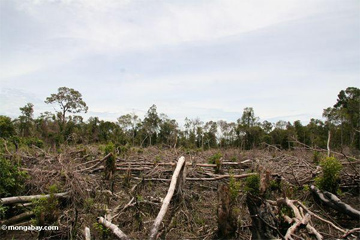With 18,000 islands spanning two major bigeographic realms (and a curious outlier in Sulawesi) across an area of nearly 2 million square kilometers, Indonesia is one of the world’s most biodiverse countries. It has the world’s third largest extent of tropical forests, has the planet’s richest coral reefs, and is home to more than 12 percent of plant and animal species. Indonesia is culturally rich as well. Its hundreds of cultures speak more than 500 languages.
But Indonesia’s biological and cultural bounties are diminished going into the second decade of the twenty-first century. Its forests and have damaged and degraded by logging and plantation development, eaten away by subsistence and industrial agriculture, mined for minerals and ore, and burned by armies of farmers and developers. At the same time, its rich waters have in some areas been overfished and fouled by pollution, its reefs mined for limestone and sea life, and its mangroves filled and cleared. Economic growth has accelerated the onslaught and exacerbated conflict over increasingly valuable land.
 Sumatran Orangutan, 2009 |
Many of the environmental issues facing Indonesia are embodied in the plight of the orangutan, the red ape that inhabits the islands of Borneo and Sumatra. Orangutan populations have plummeted over the past century, a result of hunting, habitat loss, the pet trade, and human-ape conflict (primarily on plantations and agricultural lands). Accordingly, governments, charities, and concerned individuals have ploughed tens of millions of dollars into orangutan conservation, but have little to show in terms of slowing or reversing the decline. The same can be said about forest conservation in Indonesia: while massive amounts of money have been put toward protecting and sustainable using forests, the sum is dwarfed by the returns from converting forests into timber, rice, paper, and palm oil. So orangutans—and forests—continue to lose out to economic development, at least as conventionally pursued. Poor governance means that even when well-intentioned measures are in place, they are often undermined by corruption, apathy, or poorly-designed policies.
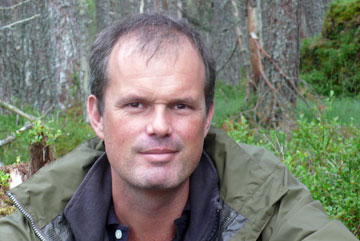 Meijaard in a Caledonian Pine forest. Photo courtesy of Erik Meijaard. |
So is there a future for Indonesia’s red apes and their forest home? Erik Meijaard, an ecologist who has worked in Indonesia since 1993 and is considered a world authority on orangutan populations, is cautiously optimistic, although he sees no ‘silver bullet’ solutions.
“Conservation is incredibly complex,” he explained during a July interview with mongabay.com. “When people talk about something not being rocket science, I ask them to consider conservation science instead. Sending a rocket into space is child’s play compared to finding optimal solutions to complex conservation problems that combine ecological, geological, economic, social, political, cultural, psychological, and other factors.”
“The longer I work in conservation, the more I become aware of this complexity, and also the more I push back against those that treat conservation as a simple ethical issue. Black and white does not work in conservation.”
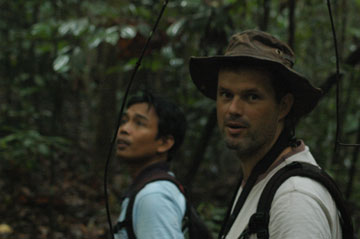 At work in forest with Nardi, TNC’s forest field coordinator. Photo courtesy of Erik Meijaard. |
Meijaard, who has worked with The Nature Conservancy (TNC), WWF, Center for International Forestry Research (CIFOR), and Tropenbos and is currently the senior forest specialist at Indonesia-based People and Nature Consulting International, uses palm oil as an example. Palm oil has come under heavy criticism from environmentalists in recent years due to rapid expansion of oil palm plantations in key orangutan habitats, yet the crop remains an important source of income for local people and a profit-driver of companies in Indonesia. The apparent tradeoff is a cause of much resentment between conservationists and the palm oil industry, and may be complicating efforts to actually protect orangutans, says Meijaard.
“Singling out one industry as the major threat over-simplifies the issue, and is therefore not likely to result in long-lasting sustainable solutions.”
“By focusing on one major issue at the time, we are unlikely to find broad solutions,” he said, noting that conservationists have mostly downplayed or overlooked a major threat to orangutans: hunting by local people, which claims more than 1,000 orangutans per year according to a recent survey in Kalimantan.
“Despite hunting being recognized as a theoretical threat to orangutans, not a single conservation program is presently doing anything about it,” Meijaard said. “This suggests that despite nearly 4 decades of conservation programs for orangutans, we are not even close to finding strategic solutions that will really succeed in slowing down the species’ decline.”
Meijaard says that orangutan conservation efforts need to take better account of human needs in seeking solutions.
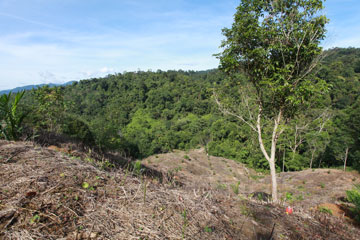 Sumatra, 2009. |
“We need more people that understand how the development processes on Borneo and Sumatra are impacting wildlife such as orangutans, and what can be realistically done to find better uses of land and forest that benefit Indonesia and Malaysia’s wildlife as well as people. These are important questions that I rarely see reflected in orangutan conservation campaigns that primarily focus on the over-used images of suffering orangutan babies and the supposedly evil plantation industries.”
Meijaard also takes issue with the amount of attention paid to orangutan welfare efforts. In a world of limited conservation funds there are tradeoffs — money for rehabilitating injured and orphaned orangutans tends to compete with money for conserving their natural habitat. Meijaard says that preliminary work is showing habitat conservation is a better use of money.
“Preliminary results suggest that estimates for the cost of rescuing, rehabilitating, reintroducing orangutans and maintaining them in the wild are initially 2–2.5 times that of protecting a similar number of orangutans in wild populations,” he said. “Since 1964, Indonesian and Malaysian orangutan rehabilitation projects have taken in at least 3,320 animals, and released around 1,250, of which ca. 625 orangutans survive (about 25%). In the same period, efforts to protect wild populations have resulted in the establishment of 20,229 km2 of protected or sustainably managed forest areas on Borneo alone, which now protect 14,280 orangutans or about a quarter of Borneo’s wild orangutans.”
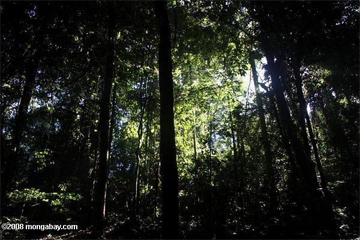
|
Meijaard says the proposed Reducing Emissions from Deforestation and forest Degradation (REDD) program, a U.N.-backed mechanism that proposes paying tropical countries for conserving their forests, could generate funds for habitat protection, but that the scheme is no panacea. Having helped set up a REDD pilot project in East Kalimantan, Meijaard argues that to be successful, REDD will have to go beyond the money to build political will for the stewardship of forests as healthy and productive ecosystems, rather than a short-term extractive resource. Meijaard says the government will need to confront powerful entrenched interests of the forestry sector that have traditionally determined forest policy. In the end, he adds, it is the Indonesian government—not donors, international environmentalists, or Western consumers—that will determine the fate of the country’s forests.
“Indonesia is a democratic society and major changes are most likely to occur if they are happening from within. I would certainly like to see those changes happen faster, but after witnessing nearly 20 years of ongoing conservation failure—interspersed with the only the occasional success—I have become convinced that the main agent of change in this country will have to be the government and its electorate,” he said.
“Consuming countries, their consumers, governments and NGOs should be smart and work out where and how they can best stimulate the process of change. And to get there, it would be good to see a bit more return on investment thinking. It is easy enough to fund environmental conservation, but few seem to ask seriously what has actually been achieved.”
Meijaard discussed these issues and more in his July 2010 interview with mongabay.com’s Rhett Butler.
AN INTERVIEW WITH ERIK MEIJAARD
Rhett Butler, mongabay.com: What is your background and what prompted you to work in conservation?
Eric Meijaard:
I grew up on the shores of Holland and among German pine forests, where my first pair of binoculars opened my eyes to the life of birds and mammals. After a visit to a greenhouse in Holland, I decided to become a farmer but a teacher told me that I could do better and should go to university. University wasn’t a great success, however, and I dropped out after a year. The next few years I spent traveling. The Himalayas and Australian deserts were my first real experiences with Big Nature and I became increasingly inspired and motivated to do something with conservation. Back home, I raced through an MSc course in Tropical Ecology which ended with one year of field research in a national park in East Java, Indonesia, where I studied the intricacies of the decay of deer dung. It was also my first experience with the poor management of Indonesia’s national parks. Back in Holland, in 1993, I was offered a job to survey orangutans and other big mammals in Indonesian Borneo, which I did for 3 years, and from then on I have consistently worked in conservation in Indonesia, for a range of organizations including WWF, The Nature Conservancy, Tropenbos-International, and as a consultant for CIFOR. Between 2000 and 2004, I spent a few years which I spent in Australia for my PhD research on the palaeoenvironments of the Malay Archipelago.
mongabay.com: Has the focus of your work changed over the years and why?
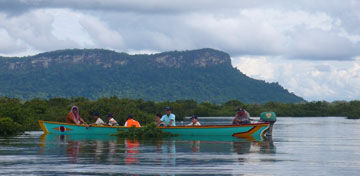 Field trip with Cambodian study group to Danau Sentarum NP to study forest honey certification. Photo courtesy of Erik Meijaard. |
Eric Meijaard:
I started in Indonesia as a scientist and even though I have held management positions in conservation organizations and presently work as a consultant, I have never stepped away from science. I like to see myself as an applied conservation scientist who seeks answers to the questions of day-to-day conservation practitioners – not science for the sake of science, but science for the sake of being used. A study which I did with Douglas Sheil of CIFOR a few years ago, showed how rare useful conservation science actually is. A lot of studies are done that supposedly benefit conservation, but in the end the bridge between scientific findings and their application is rarely crossed. This is a real problem. Conservation is incredibly complex. When people talk about something not being rocket science, I ask them to consider conservation science instead. Sending a rocket into space is child’s play compared to finding optimal solutions to complex conservation problems that combine ecological, geological, economic, social, political, cultural, psychological, and other factors. The longer I work in conservation, the more I become aware of this complexity, and also the more I push back against those that treat conservation as a simple ethical issue. Black and white does not work in conservation.
Orangutans
mongabay.com: Have you seen a shift in the primarily threat to orangutans in recent years?
 Too many people in Borneo, orangutans are just another piece of bushmeat, or a threat to their gardens. Photo courtesy of Erik Meijaard. |
Eric Meijaard:
A good example of the disconnect between science and conservation practice is seen with orangutans. It is surprising how little we know about what threatens orangutans. Of course, plantation development has often been highlighted as the threat to orangutans, but I don’t believe that is necessarily the case. Forest clearing for plantations has obviously destroyed large areas of former orangutan habitat – any remote sensing analysis will show that. But still, in reality, most oil palm development happens outside orangutan habitat. Singling out one industry as the major threat over-simplifies the issue, and is therefore not likely to result in long-lasting sustainable solutions. In the 1990s, unsustainable logging of natural forests and poorly planned transmigration programs were considered the main threats to orangutans. In the 21st century it became oil palm and more recently pulp and paper plantations. And probably in 10 years from now, it will be something else, mining or maybe some new agricultural commodity on the market. I am not saying that these shifts in land use and threats to orangutan habitats are not real, but by focusing on one major issue at the time, we are unlikely to find broad solutions. In addition, orangutan conservationists seem to have overlooked one of the main threats to remaining orangutans, at least in Kalimantan, i.e. hunting. Recent interviews of nearly 7000 villagers in Kalimantan revealed that over a thousand orangutans are still killed annually by local people, of which more than 50% is for food. Despite hunting being recognized as a theoretical threat to orangutans, not a single conservation program is presently doing anything about it. This suggests that despite nearly 4 decades of conservation programs for orangutans, we are not even close to finding strategic solutions that will really succeed in slowing down the species’ decline. Why that is, I can only guess at, but obviously, there is still a lack of good conservation research on orangutans, or the findings of such research are not used by practitioners. We need more people that understand how the development processes on Borneo and Sumatra are impacting wildlife such as orangutans, and what can be realistically done to find better uses of land and forest that benefit Indonesia and Malaysia’s wildlife as well as people. These are important questions that I rarely see reflected in orangutan conservation campaigns that primarily focus on the over-used images of suffering orangutan babies and the supposedly evil plantation industries.
mongabay.com: With finite resources for orangutans and growing threats to their survival in the wild, there seems to be an inherent conflict between animal welfare measures (like rehabilitation) and conservation approaches (protected areas). Do you have thoughts on how to prioritize use of funds allocated for orangutans? Can rehabilitation programs be an effective conservation strategy?
 Kalimantan, 2006 |
Eric Meijaard:
Most orangutans in captivity have come from former habitats that have been cleared for non-forest use. Orangutans will keep ending up in captivity as long as their remaining habitat is not effectively managed or protected. With 75% of all orangutans occurring outside protected areas where forest use and conversion is legal, we should not expect that rehabilitation programs can be shut down any time soon. In its Action Plan, the Indonesian government has committed itself to stabilizing all remaining wild populations by 2017. This is obviously an enormous challenge, but it is the only solution that will eventually slow done the intake levels of orangutans in the rehabilitation centers. Rehabilitation is important from an animal welfare perspective, and also to accommodate law enforcement, but it is not a particularly effective conservation strategy. The significant media attention given to orangutan rehabilitation gives the impression that it does a lot of good for orangutans, but I think that impression is wrong—just look at the post-release mortality rates which are very high. Together with some colleagues I am presently working on an analysis of optimal resource allocation in orangutan conservation, weighing the costs and benefits of rehabilitation vs habitat conservation. Preliminary results suggest that estimates for the cost of rescuing, rehabilitating, reintroducing orangutans and maintaining them in the wild are initially 2–2.5 times that of protecting a similar number of orangutans in wild populations. Since 1964, Indonesian and Malaysian orangutan rehabilitation projects have taken in at least 3,320 animals, and released around 1,250, of which ca. 625 orangutans survive (about 25%). In the same period, efforts to protect wild populations have resulted in the establishment of 20,229 km2 of protected or sustainably managed forest areas on Borneo alone, which now protect 14,280 orangutans or about a quarter of Borneo’s wild orangutans. To a certain extent, rehabilitation and habitat conservation are complimentary strategies, but I sometimes wish that governments, media, and also NGOs would pay more attention to the latter rather than the former.
Deforestation and REDD
mongabay.com: Your work in Indonesia has coincided with an era of political change (the Suharto era, the post-Suharto period of chaos, and the present democratic era). Has there been a shift in the way conservation is perceived in the country or is it still largely the same actors involved in the same activities?
Eric Meijaard:
During the Suharto era, environmental issues were rarely mentioned in the media and there were hardly any local environmental NGOs. This has changed a lot. Local environmental awareness has grown considerably; just to give an example, ask anyone in Indonesia and they will have some knowledge of the link between floods and landslides and deforestation. At the same time however there has been a rapid increase in economic development in the country, and a breakdown of law and order in the post-Suharto period, which has led to a rapid depletion of the countries natural resources. I am moderately optimistic about the development of environmental ethics among Indonesia’s people. The question is when people will care enough for their environment to start slowing down or stop further environmental degradation, and what Indonesia’s natural environments will look like at that point. This is a process that all countries in the world seem to go through. Socio-economic development occurs at the expense of forests and other ecosystems. With rising welfare environmental awareness generally increase to a point where people agree to allocate enough resources to slow down or stop further environmental decline.
mongabay.com: Do you see opportunities to engage interests outside the forestry sector (perhaps manufacturing) in reducing deforestation? Could an alliance of these corporations, which collectively employ millions of people, present a formidable political voice to counter the influential individuals and companies in the forestry sector?
 Let Djitaq. The inspiring leader of the Wehea people. Photo courtesy of Erik Meijaard. |
Eric Meijaard:
Indonesia is one of the fastest developing countries in the world. Its rate of economic growth is only just behind China and India, and its stock exchange outperforms pretty much every other one. The eyes of the world are thus on Indonesia and with that comes an increasing need to act responsibly. Companies are becoming aware that if they want to operate internationally, they need to adhere to certain internationally recognized guidelines. This is a slow process, and in the plantation, mining, and timber industries it is not yet translating in much improvement in management. Apparently, the incentives are not enough and the sanctions too light. That is not to say that no one is trying. I see plenty of well-intentioned management from companies in a range of natural resource sectors. But overall, Indonesia is still far too often in the international media because of some environmental mismanagement issue—deforestation, illegal logging, plantation development, orangutans, you name it. This has now become a significant PR issue for the country, and the negative image conveyed through the media may have an impact on other sectors that have little to do with natural resource use. For example, how much less revenue does the tourism industry earn because of how potential visitors perceive the country’s environmental management? I don’t know the economic losses that Indonesia incurs because of its poor environmental image, but it might well be enough for companies not involved with natural resource to take notice. There might be opportunities to engage those sectors and get them to put internal pressure on the government to more seriously improve the country’s environmental performance.
mongabay.com: Now that Norway has put $1 billion on the table, are policy makers and other decision makers in Indonesia seeing forest conservation as an opportunity rather than a “special interests” issue of environmentalists? Could REDD be the path forward for engaging the forestry sector?
Eric Meijaard:
The Norwegian initiative is laudable, and it is among the first countries to seriously address Indonesia’s long-term request: “if you want us to protect our forest, compensate us for not cutting them down”. With the Indonesian President firmly behind this carbon initiative it is likely that REDD will be taken seriously. I suspect that the Norwegian funds will provide a significant incentive to develop and test REDD pilot projects and work out the complex mechanisms through which carbon revenues will be managed. On the other hand, we shouldn’t overestimate the impact of Norwegian funds on Indonesia’s REDD development. For example, the 1 billion is only a small percentage of what Indonesia earns through oil palm and pulp and paper development. So, the success of the financial contributions of Norway and other countries really depends on whether those funds are used as effective seed money to develop viable REDD projects. I have witnessed a variety of environmental aid projects sponsored by international governments, and they do not tend to be the most effective and efficient ways to convert dollars into tangible and lasting environmental results. But let’s see what is going to happen next. I hope to see some fully functioning REDD projects within the next 5 years, with concomitant revenue streams to relevant stakeholders efficiently functioning and reliable monitoring processes in place. And of course resulting in a real reduction in forest loss rates.
mongabay.com: What are the biggest challenges to making REDD a success in Indonesia?
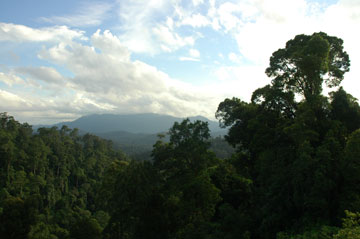 The views for which we do this work. Photo courtesy of Erik Meijaard. |
Eric Meijaard:
The success of REDD in Indonesia will depend largely on whether mechanism and markets can be developed in which key stakeholders reap more benefits from keeping forests than from cutting them down. There are still a lot of people who are earning a very good living cutting trees and draining peats, and these people have a vested interest in business as usual. Making REDD work is not just about money. The Indonesian Government plays a key role in showing the political will to antagonize those vested interests, and effectively steering the wealth transfer that would occur if REDD were to become successful.
mongabay.com: What are some of the areas, in terms of conservation, that REDD will not likely address in Indonesia? What are the chief obstacles–beyond what we’ve already discussed–to protecting and sustainably using Indonesia’s forests?
Eric Meijaard:
I am with those who say that poverty is one of the key drivers, behind Indonesia’s deforestation. Alleviating poverty is therefore one of the most important long-term solutions to solving Indonesia’s environmental problems. Other issues that need to be addressed include poor governance, corruption, better education, and resolution of land tenure insecurity. REDD is not going to solve these problems. I also don’t think that REDD will take over from other natural resource sectors as a main driver of rural development. But REDD can help shift the balance. For REDD to function, better governance, reduced corruption, resolution of land tenure etc is all required and a clear picture of how local communities will benefit from REDD. Successful REDD projects will provide significant leverage for improving forest and land management outside the carbon sector. Assuming Indonesia remains politically stable, in the end, all these improvements should bring about reduced poverty, and generally increased welfare reduces forest loss. But these are not simple equations and ultimately it is the Indonesian government that decides which forests will stay and which will go.
Consumption
mongabay.com: Deforestation in Indonesia is primarily driven by demand for commodities, especially timber, pulp, and palm oil. Given this, how important are commodity roundtables and certification systems–perhaps linked with REDD payments–in enticing producers to adopt practices that are less damaging to the environment? Is there enough incentive from consumer demand or does there need to be regulation to ensure the success of these schemes?
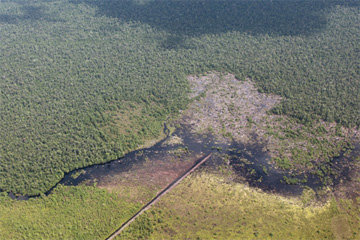 Kalimantan, 2009 |
Eric Meijaard:
I am not impressed with the achievements of certification systems in Indonesia. After nearly 2 decades there are still only a handful of timber concessions with FSC certification, and I am not even sure that this has done much good for forests. We have studied forest loss in certified timber concessions, and the small data set suggest that forest loss is at about the same level as in non-certified concessions in similar topographical areas. Maybe micro-management of forests is actually better in certified concessions, but I don’t think the overall difference is very large. Similarly, the bar for RSPO certification appears to be too low and it is unclear what environmental benefits have resulted from certification in the oil palm industry. It may simply be a cost benefit assessment that companies make. It is nice to be internationally certified, especially if you are targeting international markets, but is it worth the investment? After initial enthusiasm in various sectors, companies may now have worked out that even when they have been certified they still get criticized by NGO and consumer groups. The general benefit of certification is that clear, commonly agreed guidelines are developed that indicate what good environmental and social management could look like. The use of High Conservation Value Forests is one example of guidelines coming out of certification that have taken on a much broader role in natural resource management, the principles and ideas of which have also become incorporated in government policy. So overall, certification plays a role in improving environmental management in forests, but it would have been nice to see more progress. It seems that the incentives to keep business as usual are still higher than those offered by certification.
mongabay.com: In Indonesia and Malaysia, loggers and palm oil producers often complain that campaigns by environmentalists are “imperialistic” or an attempt to establish trade barriers to protect agricultural interests in Europe and the United States. Do major NGOs ever go too far in demonizing industries — palm oil, timber, and paper pulp — that generate a lot of jobs and income in Indonesia? If so, what do you see as the role of activist groups in addressing deforestation?
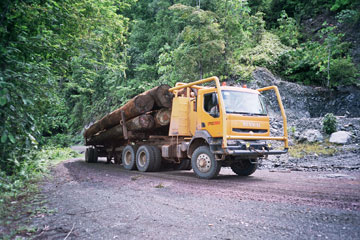 Friend of Foe? Photo courtesy of Erik Meijaard. |
Eric Meijaard:
NGOs, both the international and local ones, have played an important role over the last few decades in changing the course of conservation policy and management in Indonesia. Many positive changes have taken place, for example the slowly improving management of timber concessions, the environmental and social standards by which plantations should work, and also government policies on land use. Obviously the NGOs have not done enough, because we still see rapidly dwindling environmental values and natural resources in the country. But one could argue that this was going to happen anyway; all countries have depleted their natural resources on the road to economic and social development. The question then becomes to what extent NGOs have been able to slow down loss of conservation values or direct the development process. I often wonder these days whether certain environmental groups are going too far in demonizing the ‘big industries’. Everyone in the country takes part in environmental degradation and development – government, big industries, medium industries, small industries (for example, local farmers). I don’t believe that picking on only one group, or within that a subset of selected companies, these NGOs will see a major change in Indonesian management of forests. At best they increase the operational costs for those companies (loss of market access, higher PR costs etc.), thereby opening up opportunities to other companies (their competitors). In the end, the system remains unchanged, and all actors will largely keep doing what they were doing. Everyone is part of the problem and of the solution, and I don’t think any particular group stands out as more ‘evil’ than others. Long-term solutions will have to include all stakeholders and somehow fit into Indonesia’s overall development path.
mongabay.com: Much of the focus with NGOs is on international organizations or at least groups that are affiliated with international organizations. What about community groups? Would building the capacity of these organizations — perhaps at the provincial and even national scale — help translate local concerns into policy action?
Eric Meijaard:
The few successful conservation projects that I am familiar with in Indonesia all had one key attribute: leadership. Setting up community groups and building their capacity might only be effective if there is someone in that community who can lead, and dares to talk and stand up to others who are higher up in the hierarchy. I often think that this aspect of conservation is neglected. Getting some people around the table to work jointly on one issue isn’t that difficult. But to keep them there, and united, in the face of adversity is the challenge. People may have other things on their minds than local environmental issues, and it takes the inspiration of a leader to set the course. Without strong leadership, community groups, environmental fora, conservation networks etc. generally do not last much beyond the first external funding round. Maybe that is what Indonesia requires more than anything, a big group of committed conservation leaders who can inspire the rest of the people, set examples, and push governments for change.
mongabay.com: Do you see much potential for developing community-based sustainable forestry as a way to compete with, and eventually reduce, illegal logging?
Eric Meijaard:
Illegal logging happens when there is no control or law enforcement or if no one legally claims a forest area or manages it. Similarly, community-based sustainable forestry will require control and monitoring. If communities are well organized and they can manage to keep out free-wheelers (those who operate outside the confines of the sustainable forestry system), community-based projects might have great potential. The question is who provides the control. This could partly come from markets and independent auditors who ensure that the management is indeed sustainable. Alternatively it could come from the government. Either way, because of the scale of community-based forestry (many small projects), the bureaucracy of managing it will have to be large. I think it would be a mistake to assume that communities are naturally more sustainable in their operations than larger companies. Most people are out for quick revenues, and sustainability thinking generally needs to be brought in from outside.
mongabay.com: What role do major consuming countries have in ensuring a future for Indonesia’s forests?
Eric Meijaard:
I am not convinced that major consuming countries will have a big influence on Indonesia’s forests. For all our jumping up and down, noise in the press, government protests, and international legislation and sanctions, the broader international community has not had much impact on the course of deforestation in Indonesia. Indonesia is a democratic society and major changes are most likely to occur if they are happening from within. I would certainly like to see those changes happen faster, but after witnessing nearly 20 years of ongoing conservation failure—interspersed with the only the occasional success—I have become convinced that the main agent of change in this country will have to be the government and its electorate. Revolutionary change in environmental management through drastic action may sound nice, but I just can’t see it happen. And if it happens, it won’t be brought about from outside. So, consuming countries, their consumers, governments and NGOs should be smart and work out where and how they can best stimulate the process of change. And to get there, it would be good to see a bit more return on investment thinking. It is easy enough to fund environmental conservation, but few seem to ask seriously what has actually been achieved.
Related articles
Palm oil both a leading threat to orangutans and a key source of jobs in Sumatra

(09/24/2009) Of the world’s two species of orangutan, a great ape that shares 96 percent of man’s genetic makeup, the Sumatran orangutan is considerably more endangered than its cousin in Borneo. Today there are believed to be fewer than 7,000 Sumatran orangutans in the wild, a consequence of the wildlife trade, hunting, and accelerating destruction of their native forest habitat by loggers, small-scale farmers, and agribusiness. Gunung Leuser National Park in North Sumatra is one of the last strongholds for the species, serving as a refuge among paper pulp concessions and rubber and oil palm plantations. While orangutans are relatively well protected in areas around tourist centers, they are affected by poorly regulated interactions with tourists, which have increased the risk of disease and resulted in high mortality rates among infants near tourist centers like Bukit Lawang. Further, orangutans that range outside the park or live in remote areas or on its margins face conflicts with developers, including loggers, who may or may not know about the existence of the park, and plantation workers, who may kill any orangutans they encounter in the fields. Working to improve the fate of orangutans that find their way into plantations and unprotected community areas is the Orangutan Information Center (OIC), a local NGO that collaborates with the Sumatran Orangutan Society (SOS).
Rehabilitation not enough to solve orangutan crisis in Indonesia

(08/20/2009) A baby orangutan ambles across the grass at the Borneo Orangutan Survival Foundation’s Nyaru Menteng rehabilitation center in Central Kalimantan, in the heart of Indonesian Borneo. The ape pauses, picks up a stick and makes his way over to a plastic log, lined with small holes. Breaking the stick in two, he pokes one end into a hole in an effort to extract honey that has been deposited by a conservation worker. His expression shows the tool’s use has been fruitful. But he is not alone. To his right another orangutan has turned half a coconut shell into a helmet, two others wrestle on the lawn, and another youngster scales a papaya tree. There are dozens of orangutans, all of which are about the same age. Just outside the compound, dozens of younger orangutans are getting climbing lessons from the Borneo Orangutan Survival Foundation (BOS) staff, while still younger orangutans are being fed milk from bottles in a nearby nursery. Still more orangutans—teenagers and adults—can be found on “Orangutan Island” beyond the center’s main grounds. Meanwhile several recently wild orangutans sit in cages. This is a waiting game. BOS hopes to eventually release all of these orangutans back into their natural habitat—the majestic rainforests and swampy peatlands of Central Kalimantan, on the island of Borneo. But for many, this is a fate that may never be realized.
Orangutan guerrillas fight palm oil in Borneo

(06/01/2009) Despite worldwide attention and concern, prime orangutan habitat across Sumatra and Borneo continues to be destroyed by loggers and palm oil developers, resulting in the death of up to 3,000 orangutans per year (of a population less than 50,000). Conservation groups like Borneo Orangutan Survival report rescuing record numbers of infant orangutans from oil palm plantations, which are now a far bigger source of orphaned orangutans than the illicit pet trade. The volume of orangutans entering care centers is such that these facilities are running out of room for rescued apes, with translocated individuals sometimes waiting several months until suitable forest is found for reintroduction. Even then they aren’t safe; in recent months loggers have started clearing two important reintroduction sites (forests near Bukit Tigapuluh National Park in Sumatra and Mawas in Central Kalimantan). Meanwhile across half a dozen rehabilitation centers in Malaysia and Indonesia, more than 1,000 baby orangutans—their mothers killed by oil palm plantation workers or in the process of forest clearing—are being trained by humans for hopeful reintroduction into the wild, assuming secure habitat can be found. Dismayed by the rising orangutan toll, a grassroots organization in Central Kalimantan is fighting back. Led by Hardi Baktiantoro, the Center for Orangutan Protection (COP) has mounted a guerrilla-style campaign against companies that are destroying orangutan habitat in Kalimantan, the Indonesian part of Borneo.
